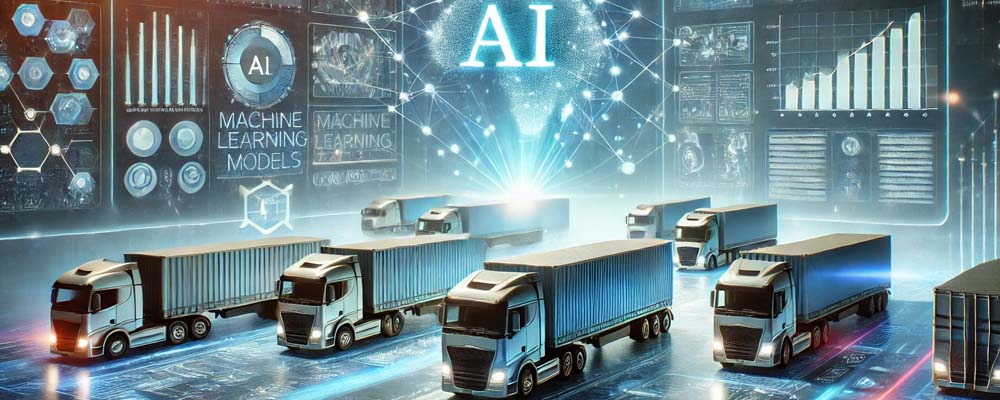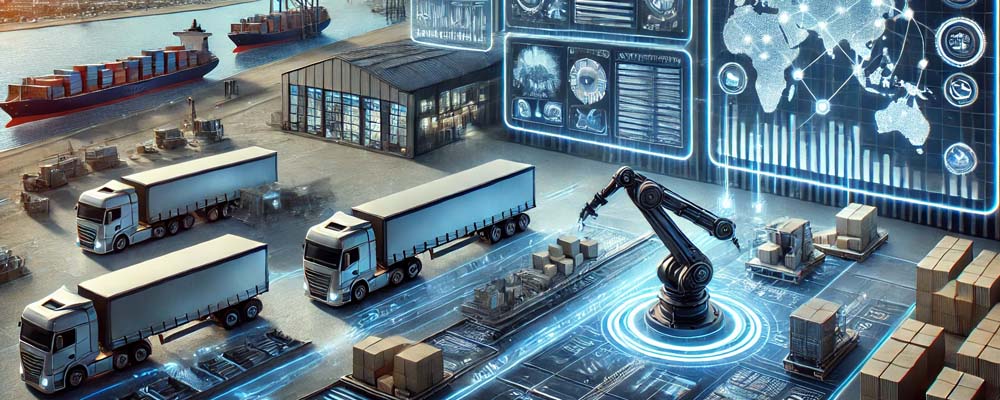
In today’s fast-changing global market, freight forwarders face growing pressure to meet demands for speed, accuracy, and cost-efficiency. Digital transformation is key to staying competitive and enhancing services through advanced technologies. This article explores the technologies driving this shift, providing insights on how logistics providers, importers, exporters, and e-commerce businesses can streamline operations and boost performance.
1. The Role of Automation and Robotics in Freight Forwarding
Automation and robotics have revolutionized various sectors of the logistics industry, particularly in warehousing and transportation. These technologies offer freight forwarders the opportunity to automate repetitive, manual tasks, resulting in improved efficiency, reduced labor costs, and minimized errors. Here are some of the key automation technologies transforming the freight forwarding landscape:
Automated Guided Vehicles (AGVs)
AGVs are autonomous vehicles used to transport materials within warehouses and distribution centers. These vehicles follow pre-programmed routes, guided by sensors, beacons, or magnetic strips, reducing the need for manual intervention. AGVs improve the speed and accuracy of material handling processes, allowing freight forwarders to manage larger volumes of goods with fewer errors. This enhances overall warehouse efficiency and reduces operational costs.
Automated Storage and Retrieval Systems (ASRS)
ASRS is a technology designed to store and retrieve goods in a highly efficient and automated manner. This system integrates with AGVs to create a fully automated warehouse, moving and storing goods without human intervention. ASRS improves space use, accuracy, and speeds up processing, ideal for large inventories.
Robotic Picking and Packing
Robotic picking and packing systems are increasingly being used to automate the order fulfillment process. Equipped with sensors and vision systems, these robots identify, pick, and pack products precisely, reducing errors, speeding up processing, and boosting customer satisfaction.
Key Benefits of Automation and Robotics:
- Increased productivity through faster processing of goods
- Reduction in human error and labor costs
- Improved accuracy in inventory management and order fulfillment
- Enhanced scalability, enabling companies to handle fluctuating demand more effectively
 2. Artificial Intelligence (AI) and Machine Learning (ML): Optimizing Freight Operations
2. Artificial Intelligence (AI) and Machine Learning (ML): Optimizing Freight Operations
Artificial intelligence (AI) and machine learning (ML) have emerged as powerful tools in optimizing logistics operations, transforming how freight forwarders manage routes, predict demand, and enhance customer service. These technologies can analyze vast amounts of data, offering actionable insights that enable companies to make data-driven decisions and improve overall efficiency.
Route Optimization
AI-powered algorithms can analyze real-time data such as traffic conditions, weather forecasts, road closures, and fuel costs to determine the most efficient routes for transportation. This not only reduces transit times but also lowers fuel consumption and operational costs. Freight forwarders benefit from optimized delivery schedules and enhanced on-time performance, which are critical in meeting customer expectations for fast, reliable service.
Demand Forecasting
Machine learning algorithms can predict future demand for transportation services by analyzing historical data and market trends. This enables freight forwarders to adjust capacity, plan for peak periods, and avoid costly shortages or surpluses. Accurate demand forecasting helps logistics providers optimize resource allocation and reduce waste, contributing to better cost management and operational efficiency.
AI-Powered Customer Service
AI-powered chatbots and virtual assistants are transforming customer service in the logistics industry by providing 24/7 support. These systems can handle routine inquiries, track shipments, and resolve common issues without human intervention. By automating customer service functions, freight forwarders can reduce response times, improve customer satisfaction, and free up staff to focus on more complex tasks.
Predictive Maintenance
AI can also be used to predict when equipment, such as vehicles or machinery, is likely to fail, enabling preventative maintenance to be scheduled in advance. This reduces unplanned downtime, lowers repair costs, and ensures that operations continue smoothly without interruptions. Predictive maintenance helps logistics providers maintain high levels of operational efficiency and avoid costly delays.
Key Benefits of AI and Machine Learning:
- Optimized routing, reducing fuel consumption and transit times
- Improved demand forecasting, enabling better resource allocation
- Enhanced customer service through automated systems
- Reduced downtime and maintenance costs through predictive maintenance
 3. Blockchain Technology: Enhancing Transparency and Security
3. Blockchain Technology: Enhancing Transparency and Security
Blockchain technology has garnered attention for its potential to revolutionize supply chains by providing greater transparency, security, and traceability. For freight forwarders and customs brokers, blockchain offers a decentralized, tamper-proof system for recording and sharing data across all parties in the supply chain, creating a more secure and efficient logistics network.
Transparency in the Supply Chain
Blockchain creates a transparent, immutable record of the movement of goods, allowing all stakeholders, from manufacturers to customers, to track shipments in real-time. This visibility reduces the risk of fraud and errors, enabling companies to monitor every stage of the logistics process and address issues promptly.
Enhanced Security
Data stored on the blockchain is highly secure and difficult to tamper with. This is particularly important in an industry where sensitive information, such as customs documents, shipping manifests, and payment details, are frequently exchanged. By using blockchain, freight forwarders can enhance the security of their operations, reduce the risk of data breaches, and ensure the integrity of their transactions.
Traceability of Goods
Blockchain technology allows for the complete traceability of products, from the point of origin to the final destination. This is especially valuable for industries that require compliance with strict regulations, such as pharmaceuticals or food products, where knowing the provenance of goods is critical. Blockchain ensures that goods are handled in accordance with regulations and ethical standards, providing confidence to customers and regulators alike.
Smart Contracts
Smart contracts are automated contracts where the agreement’s terms are embedded directly into code. These contracts can automatically trigger specific actions, such as payments or the release of goods, once predefined conditions are met. This reduces the need for manual paperwork, streamlines processes, and minimizes the potential for disputes between parties.
Key Benefits of Blockchain:
- Increased transparency across the supply chain
- Enhanced security of sensitive data and transactions
- Improved traceability, ensuring compliance with regulations
- Automation of processes through smart contracts, reducing paperwork and delays
 4. The Impact of Digital Transformation on Freight Forwarding Companies
4. The Impact of Digital Transformation on Freight Forwarding Companies
The digital transformation of freight forwarding is reshaping logistics operations, offering significant benefits. By adopting technologies like automation, AI, and blockchain, freight forwarders can boost efficiency, cut costs, and improve customer satisfaction, directly enhancing their bottom line. Here are some of the key impacts of digital transformation on the industry:
Improved Operational Efficiency
Automation and AI help streamline day-to-day operations, enabling freight forwarders to handle more shipments in less time with greater accuracy. The use of robotics in warehouses, AI-powered route optimization, and predictive maintenance ensures that operations run smoothly, minimizing delays and reducing costs associated with inefficiencies.
Cost Savings
By reducing the reliance on manual labor, automating routine tasks, and optimizing routes, digital technologies enable freight forwarders to achieve significant cost savings. AI-driven demand forecasting helps avoid overstocking or under-utilization of assets, while blockchain eliminates the need for redundant paperwork, reducing administrative costs.
Enhanced Customer Experience
The integration of digital technologies such as AI-powered customer service, real-time shipment tracking, and blockchain-enhanced transparency allows freight forwarders to provide a higher level of service to their customers. The ability to offer faster, more accurate responses to inquiries and provide detailed shipment visibility contributes to increased customer satisfaction and loyalty.
Competitive Advantage
Companies that embrace digital transformation can differentiate themselves from competitors by offering superior service levels, faster delivery times, and more cost-effective solutions. In a highly competitive market, digital transformation is not just an option—it’s a necessity for staying ahead.
Sustainability and Compliance
Digital technologies can also help freight forwarders meet growing demands for sustainability and regulatory compliance. AI-driven route optimization reduces fuel consumption, while blockchain ensures that goods are sourced and transported ethically and in compliance with regulations. This not only benefits the environment but also positions companies as socially responsible players in the market.
 Conclusion
Conclusion
The freight forwarding industry is transforming through digital technologies like automation, AI, and blockchain. These innovations boost efficiency, cut costs, improve customer satisfaction, and build resilient supply chains. As the market evolves, forwarders embracing digital transformation will thrive, while those who don’t risk falling behind. Investing in technology today creates a more agile, efficient, and competitive business model for tomorrow’s economy. The time to embrace digital transformation is now.




 2. Artificial Intelligence (AI) and Machine Learning (ML): Optimizing Freight Operations
2. Artificial Intelligence (AI) and Machine Learning (ML): Optimizing Freight Operations 3. Blockchain Technology: Enhancing Transparency and Security
3. Blockchain Technology: Enhancing Transparency and Security 4. The Impact of Digital Transformation on Freight Forwarding Companies
4. The Impact of Digital Transformation on Freight Forwarding Companies Conclusion
Conclusion



